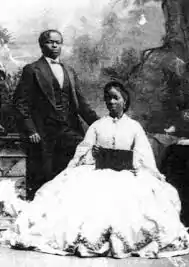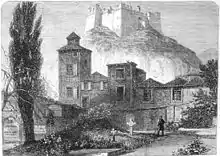Sara Forbes Bonetta
Sara Forbes Bonetta, (born Omoba Aina; 1843 – 15 August 1880),[1] was an Egbado princess of the Yoruba people in West Africa who was orphaned during a war with the nearby Kingdom of Dahomey and later became the slave of King Ghezo of Dahomey. In a remarkable twist of events, she was liberated from slavery by Captain Frederick E. Forbes of the British Royal Navy and became a goddaughter to Queen Victoria. She was married to Captain James Pinson Labulo Davies, a wealthy Lagos philanthropist.
Sara Forbes Bonetta Davies | |
|---|---|
_(cropped).jpg.webp) Sara Forbes Bonetta photographed by Camille Silvy in 1862 | |
| Born | Aina 1843 |
| Died | 15 August 1880 (aged 36–37) Funchal, Madeira Island, Portugal |
| Cause of death | Tuberculosis |
| Resting place | Funchal, Madeira Island, Portugal |
| Other names | Aina |
| Spouse(s) | |
| Children |
|
| Relatives | John Randle (physician) (son-in-law) Ameyo Adadevoh (great-great-granddaughter) |
Early life

Originally named Omoba Aina, she was born in 1843 in Oke-Odan, an Egbado village.[2] In 1848, Oke-Odan was invaded and captured by the Dahomeyan army. Aina's parents died during the attack and other residents were either killed or sold into the Atlantic slave trade.
Aina ended up in the court of King Ghezo as a slave at the age of five. However, two years later, Captain Frederick E. Forbes of the Royal Navy arrived at the Kingdom of Dahomey on a British diplomatic mission to negotiate an end to Dahomey's participation in the Atlantic slave trade.[3]
King Ghezo refused to end Dahomey's slave trade and instead offered Aina as a "gift".[4] Out of moral concern for Aina's likely and deadly fate of being executed in a traditional Dahomeyan human sacrifice ceremony, Captain Forbes accepted her on behalf of Queen Victoria and returned to Britain, with plans for the British government to be responsible for her care.[5]
Captain Forbes renamed her Sara Forbes Bonetta, after his ship HMS Bonetta. In 1850, she met the queen, who was impressed by the young princess's exceptional intelligence, and had the girl, whom she called Sally,[6] raised as her goddaughter in the British middle class.[6][7][8] In 1851, Sara developed a chronic cough, which was attributed to the climate of Great Britain. Her guardians sent her to school in Africa in May of that year, when she was aged eight.[6] She attended the Annie Walsh Memorial School (AWMS) in Freetown, Sierra Leone. The school was founded by the Church Missionary Society (CMS) in January 1849 as an institution for young women and girls who were relatives of the boys in the Sierra Leone Grammar School founded in 1845 (at first named CMS Grammar School). In the school register, her name appears only as Sally Bonetta, pupil number 24, June 1851, who got married to Captain Davies in England in 1862 and was the ward of Queen Victoria. She returned to England in 1855, when she was 12. She was entrusted to the care of Rev Frederick Scheon and his wife, who lived at Palm Cottage, Canterbury Street Gillingham. The house survives.[9] In January 1862, she was invited to and attended the wedding of Queen Victoria's daughter Princess Alice.[10]
Marriage and children

She was later given permission by the Queen to marry Captain James Pinson Labulo Davies at St Nicholas' Church in Brighton, East Sussex, in August 1862, after a period that was to be spent in the town in preparation for the wedding. During her subsequent time in Brighton, she lived at 17 Clifton Hill in the Montpelier area.[11]
Captain Davies was a Yoruba businessman of considerable wealth, and after their wedding the couple moved back to their native Africa, where they had three children: Victoria Davies (1863), Arthur Davies (1871), and Stella Davies (1873).[12] Sara Forbes Bonetta continued to enjoy a close relationship with Queen Victoria to the point such that she and Bishop Samuel Ajayi Crowther were the only Lagos indigènes the Royal Navy had standing orders to evacuate in the event of an uprising in Lagos. Victoria Matilda Davies, first daughter of Bonetta, was named after and also goddaughter of Queen Victoria.[13] She married the successful Lagos doctor Dr. John Randle, and was therefore also the stepmother of his son, Nigerian businessman and socialite J. K. Randle.[14] Stella Davies, the second daughter of Bonetta, and Herbert Macaulay, the grandson of Samuel Ajayi Crowther, had a daughter together - Sarah Abigail Idowu Macaulay Adadevoh (named after her maternal grandmother Sara and her paternal grandmother Abigail).[12] A descendant of Sara's through her line was the Ebola heroine Ameyo Adadevoh. Many of Sara's other descendants now live in either England or Sierra Leone, while a separate branch, the Randle family of Lagos, remains prominent in contemporary Nigeria.[13][15][16]
Death and legacy
Sara Forbes Bonetta died of tuberculosis on 15 August 1880[1] in the city of Funchal, the capital of Madeira Island, a Portuguese island in the Atlantic Ocean.
Her husband, Captain Davies, erected a granite obelisk-shaped monument more than eight feet high in memory of Sara Forbes Bonetta at Ijon in Western Lagos, where he had started a cocoa farm.[17] The inscription on the obelisk reads:[1]
IN MEMORY OF PRINCESS SARAH FORBES BONETTA
WIFE OF THE HON J.P.L. DAVIES WHO DEPARTED THIS LIFE AT MADEIRA AUGUST 15TH 1880
AGED 37 YEARS
Her grave is number 206 in the British Cemetery of Funchal near the Anglican Holy Trinity Church, Rua Quebra Costas Funchal, Madeira.[18]
A plaque commemorating Forbes Bonetta was placed on Palm Cottage in 2016, as part of the television series Black and British: A Forgotten History.[19]
A newly-commissioned portrait of Forbes Bonetta by artist Hannah Uzor went on display at Osborne House on the Isle of Wight in October 2020 as part of an effort by English Heritage to recognise black history in England.[20][21]
Forbes Bonetta was portrayed by Zaris-Angel Hator in the 2017 British ITV television series Victoria.[22]
Gallery
.jpg.webp) Sara Forbes Bonetta by Camille Silvy
Sara Forbes Bonetta by Camille Silvy The English Cemetery in Funchal, Madeira
The English Cemetery in Funchal, Madeira Sarah Forbes Bonettas gravestone, Madeira
Sarah Forbes Bonettas gravestone, Madeira
References
- Elebute, Adeyemo (2013). The Life of James Pinson Labulo Davies: A Colossus of Victorian Lagos. Kachifo Limited/Prestige. p. 138. ISBN 9789785205763.
- Elebute (2013), pp. 41–42
- "Black and Asian History and Victorian Britain / Sarah Forbes Bonetta and Family". Royal Collection Trust.
- "Hidden histories: the first black people photographed in Britain – in pictures: Ethiopian princes in exile, boxing champs and 'Friendly Zulus' ... these previously unseen images of black people in the Victorian times show colonialism in all its contradictions: The black Victorians: astonishing portraits unseen for 120 years". The Guardian. 15 September 2014.
- Meier, Allison C (13 April 2018). "Did Queen Victoria Really Adopt an Orphaned African Princess?". Mental Floss.
- Rappaport, Helen (2003). Queen Victoria: A Biographical Companion. ABC-CLIO Biographical Companions. p. 307. ISBN 9781851093557.
- Wasson, Ellis (2009). A History of Modern Britain: 1714 to the Present. John Wiley & Sons. p. 235. ISBN 9781405139359.
- Marsh, Jan (19 November 2009). Black Victorians: Black People in British Art 1800–1900. Lund Humphries, University of Michigan. pp. 62, 86. ISBN 9780853319306.
- Jordan, Nicola (16 October 2016). "Queen Victoria adopted my great-great grandma". Kent Online. Retrieved 6 October 2020.
- Higgen, Annie C. (1881). "Queen Victoria's African Protégée". Church Missionary Quarterly Token. Church Missionary Society. p. 6 – via Google Books.
- Collis, Rose (2010). The New Encyclopaedia of Brighton: (based on the original by Tim Carder) (1st ed.). Brighton: Brighton & Hove Libraries. ISBN 978-0-9564664-0-2.
- Elebute (2013), pp. 77-79
- Braimah, Ayodale. "Bonetta, Sarah Forbes (1843–1880)". BlackPast. Retrieved 14 August 2014.
- Adeloye, Adelola (1974). "Some early Nigerian doctors and their contribution to modern medicine in West Africa". Medical History. 18 (3): 275–93. doi:10.1017/s0025727300019621. PMC 1081580. PMID 4618303. Retrieved 23 May 2015.
- "The Nineteenth Century: 1862 - Sarah Forbes Bonetta - The African Princess in Brighton". Brighton and Hove Black History. Brighton and Hove Black History Project. Archived from the original on 8 May 2003.
- "Sarah Forbes Bonetta (Sarah Davies) (1843-1880), Goddaughter of Queen Victoria:Image archive". London: National Portrait Gallery.
- Elebute (2013), pp. 111–119
- Register of Burials, Church Archives, Holy Trinity Church, Funchal
- "Plaque commemorating Sarah Forbes Bonetta who was under the protection of Queen Victoria - BBC". Google Arts & Culture. Retrieved 7 October 2020.
- "Sarah Forbes Bonetta: Portrait of Queen Victoria's goddaughter on show". BBC News. 7 October 2020. Retrieved 7 October 2020.
- Brown, Mark (6 October 2020). "New portrait of Queen Victoria's African goddaughter unveiled". The Guardian. Retrieved 7 October 2020.
- Gordon, Naomi (20 December 2017). "Victoria creator "challenging" perspectives of the era". Digital Spy. Retrieved 7 October 2020.
Further reading
- Walter Dean Myers (1999). At Her Majesty's Request: An African Princess in Victorian England. Scholastic Press. ISBN 978-0590486699.
- Kemi Morgan and Christine Bullock, eds, The making of Good Wives, Good Mothers, Leading Lights of Society. The Story of St Anne's School Ibadan. Y Books & Associated Bookmakers of Nigeria Ltd, 1989. ISBN 9783453246
- Oyinkan Ade-Ajayi, Heritage Schools Nigeria. Phoenix Visions World Limited, 2020. ISBN 1916032826
The two books state that she was the Acting Principal of CMS Female Institution in 1870, the school was founded in 1869 ,the first principal was Mrs Annie Roper wife of Reverend Roper of CMS Mission Ijaiye, Mrs Forbes Davies was succeeded by Rev & Mrs Henry Townsend
External links
| Look up indigène in Wiktionary, the free dictionary. |
- "In focus: Sarah Forbes Bonetta". Kamal Simpson talks to Clare Gittings about Sarah Forbes Bonetta, who was photographed by Camille Silvy and featured in the National Portrait Gallery, London. YouTube.
- The Lost Child (BBC documentary)